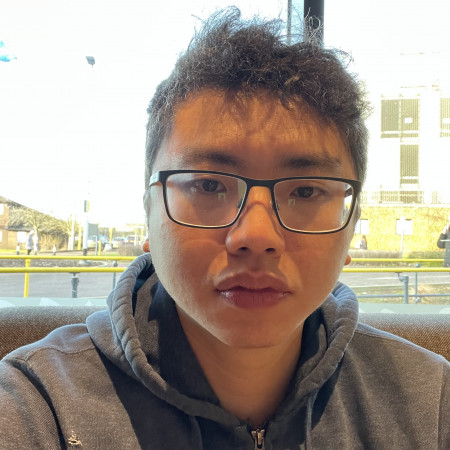
Dr Elsen Tjhung
Senior Lecturer
Biography
Dr. Elsen Tjhung is a Senior Lecturer in Applied Mathematics at the Open University (UK). He completed his PhD at the University of Edinburgh (2013), followed by postdoctoral research positions at the University of Montpellier (France) and the University of Cambridge. His research focuses on statistical physics of soft condensed matter and active/living matter.
Research interests
- Non-equilibrium statistical physics – understanding systems driven far from equilibrium, including population dynamics, living and active matter.
- Active matter theory – developing field theories for active phase separation and collective motion in biological and synthetic microswimmers.
- Stochastic thermodynamics – extending classical thermodynamics to non-equilibrium processes relevant to biological machines and microscale engines.
- Soft condensed matter hydrodynamics – modelling surfactants, colloids, liquid crystals and anisotropic particles near fluid-fluid interfaces.
- Multiphase flow and surfactant dynamics – coupling Cahn–Hilliard and Navier–Stokes equations to study interfacial phenomena.
- Computational modelling – large-scale simulations using finite element and Fourier-space methods.
Teaching interests
- For list of available PhD projects, please refer to the general PhD admission page: https://www.open.ac.uk/stem/mathematics-and-statistics/study-us/phd-research
- Author of Unit 10: Signal Analysis and the Fast Fourier Transform, from the module MST374: Computational Applied Mathematics.
External collaborations
- IOP Theory of Condensed Matter Special Interest Group, Ordinary Member (2021-2025).
Publications
Please check Google Scholar for complete list of publications.
Projects
Thermodynamics of Growing Active and Living Matter
When we learnt classical thermodynamics from undergraduate physics/chemistry, we often assumed a large number of particles ~10^23, equilibrium, and quasi-static process. In this very restrictive limit, thermodynamic quantities such as heat dissipation Q, can be computed using the textbook formula Q= T\Delta S, where S is the configurational entropy. However, in real lives, most physical processes are neither quasi-static nor equilibrium. Furthermore, in many biological systems, the number of degrees of freedom is also much less than 10^23, and in this regime, thermal fluctuations become important. Thus, thermodynamic quantities such as heat, work and entropy need to be redefined properly (Stochastic Thermodynamics). The first aim of this research is to extend the theory of stochastic thermodynamics to include birth and death process, e.g., cellular division and apoptosis in living tissues and growing bacterial colonies. One important application of stochastic thermodynamics is the prospects of biological machines, which are powered by the swimming motility in some bacteria, or even cellular division and apoptosis in our bodies. For instance, it has been well known experimentally and theoretically that if we place an asymmetric cog inside a bath full of swimming bacteria, the cog can somehow rotate persistently in one direction. The bacteria themselves, in the absence of the cog, swim in a completely random direction; and yet the interaction between the bacteria and the asymmetric cog can break time reversal symmetry to create a macroscopic unidirectional current. Although this phenomenon has been well established in motile active matter (such as swimming bacteria), very little is known about non-motile growing active matter (such as cell division and apoptosis in living tissues and bacterial colonies). In this research, I will explore cellular division and apoptosis as a new route to the development of biological machines. This is important because unlike cell motility, cell division and apoptosis are universal properties of living matter. My design principles for such machines will pave the way for future possible applications in healthcare technologies and tissue engineering, such controlling the growth of tissue using non-uniform scaffolding. Finally, I will investigate the thermodynamic properties of these machines. In particular, I will quantify the informatic entropy production of the birth and death process inside biological tissues and bacterial colonies, i.e., particles dividing into two and disappearing elsewhere. To achieve this, I will extend the current theory of stochastic thermodynamics to include birth and death process and stochastic processes that are much faster than quasi-static (i.e., quenching). This information will be crucial in understanding how time reversal symmetry breaking at small scales (i.e., cell cycle) can be translated into large scales (i.e., collective motion in tissues and bacterial colonies). Apart from obvious applications to active/living matter, my research will also help to transform the science of thermodynamics, such as understanding the energy flow in a quenching process and/or processes close to a critical point, where thermal fluctuations are important.
Publications
Journal Article
Hydrodynamics of a disk in a thin film of weakly nematic fluid subject to linear friction (2024)
Stochastic Hydrodynamics of Complex Fluids: Discretisation and Entropy Production (2022)
Capillary Interfacial Tension in Active Phase Separation (2021)
Thermodynamics of Active Field Theories: Energetic Cost of Coupling to Reservoirs (2021)